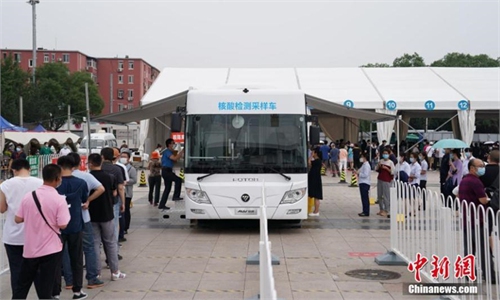Beijing-Xiong’an high-speed transit system to boost Beijing-Tianjin-Hebei integration
Dispersal of non-capital functions ‘will be more efficient’
Starting at Beijing West Railway Station and connecting Beijing's Daxing International Airport and the Xiong'an New Area in Hebei Province, the Beijing-Xiong'an intercity railway fully opened as of Sunday, with analysts saying that this project has laid the foundation for the dispersal of non-capital functions from Beijing to Xiong'an, and the railway system - with its advanced technologies - will be the leading example for urban construction in the future world.
Ticketing platform 12306.com showed all tickets for the first train from Beijing West Railway Station to Xiong'an Railway Station were sold out within a few hours of release on Saturday afternoon. Opening ceremonies were held in both the Xiong'an Railway Station and the Beijing West Railway Station. Staff from the stations, contractors and passengers attended the ceremonies.
The construction of the intercity railway was divided into two parts. The section from Beijing West Railway Station to Beijing Daxing International Airport opened on September 30, 2019.
The whole length of the Beijing-Xiong'an intercity railway is 91 kilometers. Fares range from 48 to 68 yuan ($7.35-$10.40).The designed top speed of bullet trains for this line is 350 kilometers per hour and the initial speed is set to reach 300 kilometers per hour. The Fuxing bullet train shortens the traveling time from Beijing West Railway Station to Xiong'an New Area to 50 minutes, as in the past, it took hours when there is no direct train.
Song Tingting, office director of Beijing West Railway Station, told the Global Times that from the opening of the Beijing West Railway Station to Daxing International Airport section, the intercity railway had served more than 220,000 people. "The railway network will be rearranged, based on passenger volume in the future," said Song.
Ye Tanglin, a professor with the Capital University of Economics and Business, told the Global Times that the railway system will surely boost connectivity between Beijing and Xiong'an, and this has laid the foundation for the dispersal of non-capital functions from Beijing to Xiong'an, which is a major task of the new area.
"The capital city of China and the new area, as well as Beijing's Daxing International Airport, have been linked by the system, so the airport will serve more people in the Beijing-Tianjin-Hebei region, rather than merely serving residents in Beijing. The railway system has enabled Daxing airport to become a hub that connects Xiong'an and the world," Ye said.
Chinese analysts said the construction of the railway system not only affects the regional integration in terms of traditional infrastructure, but sets a leading example for urbanization in China and even the world.
The distances between Beijing and Tianjin and Beijing and Xiong'an New Area are roughly the same, both about 140 kilometers. The intercity railway between Beijing and Tianjin takes about 30 minutes.
According to the Science and Technology Daily of China on Sunday, the Xiong'an Railway Station is the biggest newly built railway station along the route of the Beijing-Xiong'an intercity railway, as its floor area is 475,000 square meters, with 13 platforms and 23 railways, and it has been designed to be integrated into the city's construction.
The station and the railways have been made intelligent with the technologies of artificial intelligence, cloud computing, big data and green energy saving. Liu Weiqun, chairman of the China Railway Design Corp, told the media that many innovative designs were used in the general design of the Beijing-Xiong'an intercity railway, many for the first time in China.
For instance, in order to better integrate the railway and the urban landscape, the traction substation in Xiong'an has been designed as an underground sunken plaza, which is the first traction substation that lies entirely underground among railways in China, according to the Science and Technology Daily.



